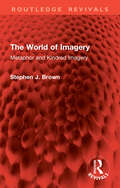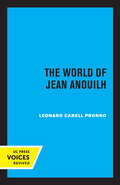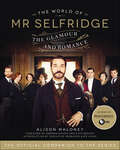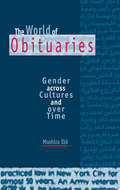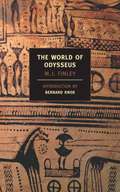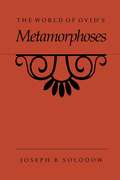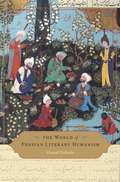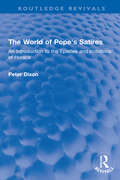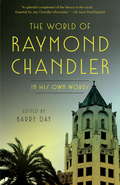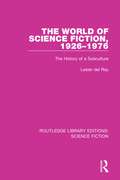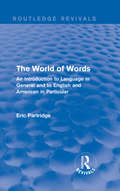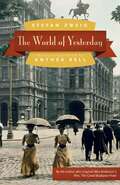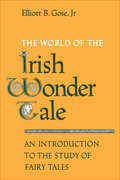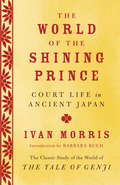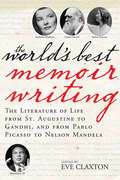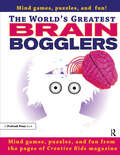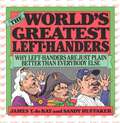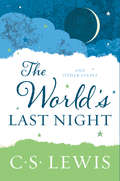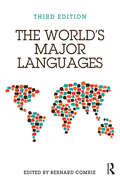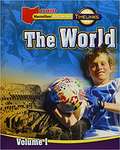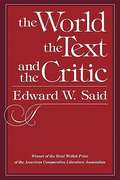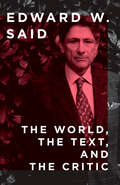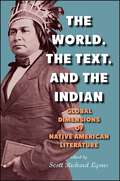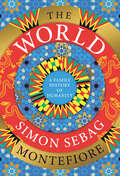- Table View
- List View
The World of Imagery: Metaphor and Kindred Imagery (Routledge Revivals)
by Stephen J. BrownOriginally published in 1927, The World of Imagery is a study of the use of metaphor, simile, and other forms of literary imagery from the ancient Hebrew to the early twentieth century. It looks at the theory, including the nature and function of metaphor, followed by the application in various settings and finally showing illustrations and examples in everyday life.
The World of Jean Anouilh
by Leonard C. PronkoThis title is part of UC Press's Voices Revived program, which commemorates University of California Press’s mission to seek out and cultivate the brightest minds and give them voice, reach, and impact. Drawing on a backlist dating to 1893, Voices Revived makes high-quality, peer-reviewed scholarship accessible once again using print-on-demand technology. This title was originally published in 1961.
The World of Mr. Selfridge: The Glamour and Romance
by Alison MaloneyThe official, full-color, illustrated, behind-the-scenes companion to the lavish hit ITV and PBS television series Mr. Selfridge that vividly brings into focus the remarkable man and his time.Set at the crossroads between the old and the new—when the Victorian and Edwardian eras gave way to the modern age—Mr. Selfridge illuminates the passions, drama, tensions, and promise of the early twentieth century, embodied in one charming, dynamic, self-made man: department store tycoon Harry Gordon Selfridge.Mr. Selfridge follows a colorful cast of characters whose lives and fortunes are entangled with the founder of the magnificent department store that bears his name: Selfridge’s. American retail visionary Harry Selfridge moves to London in 1906 with his family to establish the most ambitious department store the world had ever seen. While his dreams inspire many, they also challenge the staid conventions of British society.A saga bursting with love affairs, class divisions, cultural clashes, ambition, betrayals, and secrets, Mr. Selfridge is set in an era when women reveled in a new sense of freedom and modernity. A charming, dynamic, brilliant, and forceful man who enjoys and respects women, Harry opens the doors of his opulent department story on London's famed Oxford Street to indulge, empower and celebrate them, changing the way the British—and the world—shopped forever.Including a foreword by series producer Andrew Davies, this official illustrated companion to the series—the biggest ITV-produced drama of all time—takes fans on a journey through the world of the series, Selfridge’s, and the larger-than-life entrepreneur, husband, lover, and family man behind it. Rich with historical detail, The World of Mr. Selfridge examines the real man and the fictional character based on him, his relationship with his family, his genius for retail, and his flagship store, including its departments and changing fashions in the early twentieth century.Complete with hundreds of gorgeous photographs, The World of Mr. Selfridge takes a closer look at the cast and their characters over the first two seasons, and looks ahead to series three, which begins in 1919—when Harry’s life really begins to unravel.
The World of Obituaries: Gender across Cultures and over Time
by Mushira EidThe World of Obituaries looks at obituaries as a rich source of information on cultural representations of gender.
The World of Odysseus
by Bernard Knox M. I. FinleyThe World of Odysseus is a concise and penetrating account of the society that gave birth to the Iliad and the Odyssey--a book that provides a vivid picture of the Greek Dark Ages, its men and women, works and days, morals and values. Long celebrated as a pathbreaking achievement in the social history of the ancient world, M. I. Finley's brilliant study remains, as classicist Bernard Knox notes in his introduction to this new edition, "as indispensable to the professional as it is accessible to the general reader"--a fundamental companion for students of Homer and Homeric Greece.
The World of Ovid's Metamorphoses
by Joseph B. SolodowSynthesizing a wealth of detailed observations, Joseph Solodow studies the structure of Ovid's poem Metamorphoses, the role of the narrator, Ovid's treatment of myth, and the relationship between Ovid's and Virgil's presentations of Aeneas. He argues that for Ovid metamorphosis is an act of clarification, a form of artistic creation, and that the metamorphosed creatures in his poem are comparable to works of art. These figures ultimately aid us in perceiving and understanding the world.
The World of Persian Literary Humanism
by Hamid DabashiWhat does it mean to be human? Humanism has mostly considered this question from a Western perspective. Through a detailed examination of a vast literary tradition, Hamid Dabashi asks that question anew, from a non-European point of view. The answers are fresh, provocative, and deeply transformative. This groundbreaking study of Persian humanism presents the unfolding of a tradition as the creative and subversive subconscious of Islamic civilization. Exploring how 1,400 years of Persian literature has taken up the question of what it means to be human, Dabashi proposes that the literary subconscious of a civilization may also be the undoing of its repressive measures. This could account for the masculinist hostility of the early Arab conquest that accused Persian culture of effeminate delicacy and sexual misconduct, and later of scientific and philosophical inaccuracy. As the designated feminine subconscious of a decidedly masculinist civilization, Persian literary humanism speaks from a hidden and defiant vantage point-and this is what inclines it toward creative subversion. Arising neither despite nor because of Islam, Persian literary humanism was the artistic manifestation of a cosmopolitan urbanism that emerged in the aftermath of the seventh-century Muslim conquest. Removed from the language of scripture and scholasticism, Persian literary humanism occupies a distinct universe of moral obligations in which “a judicious lie,” as the thirteenth-century poet Sheykh Mosleh al-Din Sa’di writes, “is better than a seditious truth. ”
The World of Pope's Satires: An Introduction to the Epistles and Imitations of Horace (Routledge Revivals)
by Peter DixonFirst published in 1968, The World of Pope’s Satires is a stimulating and challenging book showing how the satires written by Pope during the 1730s were not only expressions of his own .poetic personality but were also responsive to the habits and attitudes of the age. The author considers Pope’s uses of some current conversational technique (especially that of ‘raillery’) and of the closely related social ideal of the cultivated gentleman. Pope’s regard for certain personal attributes and moral values – notably hospitality, integrity, friendship, charity and self-knowledge – is examined in two ways; as it expresses itself positively in the satires, and as it is defined negatively by his antipathy towards courtly self-seeking and hypocrisy, contemporary manifestations of acquisitiveness, and the pride associated with neo-stoicism. The final chapter is wide ranging and shows that although Pope is at times representative, and therefore limited, in his response to the pressures and uncertainties of the age, his satires live because of the subtlety of his treatment of such Augustan commonplaces as Order and Balance and the passion and spirit of his writing. This will be an interesting read for students of English literature.
The World of Raymond Chandler: In His Own Words
by Raymond ChandlerRaymond Chandler never wrote a memoir or autobiography. The closest he came to writing either was in—and around—his novels, shorts stories, and letters. There have been books that describe and evaluate Chandler&’s life, but to find out what he himself felt about his life and work, Barry Day, editor of The Letters of Noël Coward (&“There is much to dazzle here in just the way we expect . . . the book is meticulous, artfully structured—splendid&” —Daniel Mendelsohn; The New York Review of Books), has cannily, deftly chosen from Chandler&’s writing, as well as the many interviews he gave over the years as he achieved cult status, to weave together an illuminating narrative that reveals the man, the work, the worlds he created.Using Chandler&’s own words as well as Day&’s text, here is the life of &“the man with no home,&” a man precariously balanced between his classical English education with its immutable values and that of a fast-evolving America during the years before the Great War, and the changing vernacular of the cultural psyche that resulted. Chandler makes clear what it is to be a writer, and in particular what it is to be a writer of &“hardboiled&” fiction in what was for him &“another language.&” Along the way, he discusses the work of his contemporaries: Dashiell Hammett, James M. Cain, Hemingway, Fitzgerald, Agatha Christie, W. Somerset Maugham, and others (&“I wish,&” said Chandler, &“I had one of those facile plotting brains, like Erle Gardner&”).Here is Chandler&’s Los Angeles (&“There is a touch of the desert about everything in California,&” he said, &“and about the minds of the people who live here&”), a city he adopted and that adopted him in the post-World War I period . . . Here is his Hollywood (&“Anyone who doesn&’t like Hollywood,&” he said, &“is either crazy or sober&”) . . . He recounts his own (rocky) experiences working in the town with Billy Wilder, Howard Hawks, Alfred Hitchcock, and others. . .We see Chandler&’s alter ego, Philip Marlowe, private eye, the incorruptible knight with little armor who walks the &“mean streets&” in a world not made for knights (&“If I had ever an opportunity of selecting the movie actor who would best represent Marlowe to my mind, I think it would have been Cary Grant.&”) . . . Here is Chandler on drinking (his life in the end was in a race with alcohol—and loneliness) . . . and here are Chandler&’s women—the Little Sisters, the &“dames&” in his fiction, and in his life (on writing The Long Goodbye, Chandler said, &“I watched my wife die by half inches and I wrote the best book in my agony of that knowledge . . . I was as hollow as the places between the stars.&” After her death Chandler led what he called a &“posthumous life&” writing fiction, but more often than not, his writing life was made up of letters written to women he barely knew.)Interwoven throughout the text are more than one hundred pictures that reveal the psyche and world of Raymond Chandler. &“I have lived my whole life on the edge of nothing,&” he wrote. In his own words, and with Barry Day&’s commentary, we see the shape this took and the way it informed the man and his extraordinary work.
The World of Science Fiction, 1926-1976: The History of a Subculture (Routledge Library Editions: Science Fiction #3)
by Lester del ReyThis book, first published in 1980, is a guide to the major forces in the subculture of science fiction. It analyses the history of the field and the related developments, for instance the Bomb, that have shaped the literature. It examines the complex of activity and background tradition, the body of accepted beliefs and conventions, and the ethics and values of the world of science fiction.
The World of Tacitus' Dialogus de Oratoribus
by Christopher S. van den BergComing to terms with the rhetorical arts of antiquity necessarily illuminates our own ideas of public discourse and the habits of speech to which they have led. Tacitus wrote the Dialogus at a time (ca. 100 CE) when intense scrutiny of the history, the definitions, and the immediate relevance of public speech were all being challenged and refashioned by a host of vibrant intellects and ambitious practitioners. This book challenges the notion that Tacitus sought to explain the decline of oratory under the Principate. Rather, from examination of the dynamics of argument in the dialogue and the underlying literary traditions there emerges a sophisticated consideration of eloquentia in the Roman Empire. Tacitus emulates Cicero's legacy and challenges his position at the top of Rome's oratorical canon. He further shows that eloquentia is a means by which to compete with the power of the Principate.
The World of Words: An Introduction to Language in General and to English and American in Particular (Routledge Revivals: The Selected Works of Eric Partridge)
by Eric PartridgeFirst published in 1939, this book provides a brief but comprehensive view of language in general, and of English and American language in particular. It is suitable for beginners and those who wish to learn about the basics of linguistics.
The World of Yesterday
by Stefan ZweigThis book recalls the golden age of literary Vienna―its seeming permanence, its promise, and its devastating fall. <p><p> Surrounded by the leading literary lights of the epoch, Stefan Zweig draws a vivid and intimate account of his life and travels through Vienna, Paris, Berlin, and London, touching on the very heart of European culture. His passionate, evocative prose paints a stunning portrait of an era that danced brilliantly on the edge of extinction. This new translation by award-winning Anthea Bell captures the spirit of Zweig’s writing in arguably his most revealing work.
The World of the Irish Wonder Tale: An Introduction to the Study of Fairy Tales
by Elliott B. Gose Jr.Fairy tales are a rich element of childhood in many cultures around the world. But in Ireland, where they are known as wonder tales, these stories of magic and enchantment are not restricted to young audiences; Irish wonder tales are told to adults. So that the modern reader can fully appreciate them, Gose provides an interdisciplinary overview. He identifies a number of approaches – psychological, anthropological, structural, comparative, and typological.
The World of the Shining Prince: Court Life in Ancient Japan
by Ivan MorrisIvan Morris’s definitive and widely acclaimed portrait of the ceremonious and melancholy world of ancient Japan.<P> Using The Tale of Genji and other major literary works from Japan’s Heian period as a frame of reference, The World of the Shining Prince recreates an era when women set the cultural tone. Focusing on the world of the emperor’s court—a world deeply admired by Virginia Woolf, among others—renowned scholar of Japanese history and literature Ivan Morris explores the politics, society, religious life, and superstitions of the period.<P> Offering readers detailed portrayals of the daily lives of courtiers, the cult of beauty they espoused, and the intricate relations between the men and women of the age, The World of the Shining Prince has been a cornerstone text on ancient Japan for half a century
The World's Best Memoir Writing: The Literature of Life from St. Augustine to Gandhi, and from Pablo Picasso to Nelson Mandela
by Eve ClaxtonEve Claxton has taken the most intriguing portions of the world's most famous memoirs and compiled them in this volume. The reader experiences world history as the authors lived it and gains rare insight into the lives and personalities of some of the world's most important writers, thinkers, athletes and artists. From Charlie Chaplin's childhood walks through Victorian London and Alan Bennett's wartime boyhood in Yorkshire to the day Muhammad Ali discovered boxing and Mahatma Gandhi experimented with cigarettes; from Primo Levi's capture of fascist militia at twenty-one and Katherine Hepburn's first acting job at the same age to Charles Darwin on his lifelong love-his work-and Nelson Mandela on being released from prison at seventy-one. The World's Best Memoir Writing is a uniquely enjoyable immersion into some of the world's best, and most personal, writing.
The World's Greatest Brain Bogglers: Grades 3-9
On January 1st, a girl said to a boy, "Two days ago, I was 7, but next year I'll be 10." She was telling the truth. Try to figure out how this could be possible.―Pamela Massey, 12What do you have when you are sitting down that disappears when you stand up?―Lindsay Lingerman, 12Your students will love these collections of games, puzzles, logic puzzles, word finds, riddles, and mazes―all by kids just like them! Each puzzle or game is by a kid, because these challenges are collected from the pages of Creative Kids, a magazine by and for kids―so you know that the brain bogglers in these collections will be perfect for your students. Sit back as your students use logic to create a mismatched monster, decrypt secret messages, and solve picture puzzles.Filled with hours of fun and challenge, there is something for everyone in these books, from corny riddles, to perplexing crosswords, to complicated puzzles―all written by kids, but challenging for any age.
The World's Greatest Left-Handers: Why Left-Handers are Just Plain Better Than Everybody Else
by James Tertius de Kay Sandy HuffakerFrom Buzz Aldren to Queen Victoria, the fascinating foibles of the sinister set.
The World's Last Night: And Other Essays
by C. S. LewisA repackaged edition of the revered author’s anthology of satirical yet serious essays on evil.In these spirited essays, C. S. Lewis—the great British writer, scholar, lay theologian, broadcaster, Christian apologist, and bestselling author of Mere Christianity, The Screwtape Letters, The Great Divorce, The Chronicles of Narnia, and many other beloved classics—discusses evil in the world. Blending irony, humor, and paradox, he tackles religion’s most difficult and intriguing questions regarding immorality, belief, and the meaning of prayer. Best of all, the infamous Screwtape makes a special cameo appearance in this funny and poignant collection.
The World's Major Languages
by Bernard ComrieThe World's Major Languages features over 50 of the world's languages and language families. This revised edition includes updated bibliographies for each chapter and up-to-date census figures. The featured languages have been chosen based on the number of speakers, their role as official languages and their cultural and historical importance. Each language is looked at in depth, and the chapters provide information on both grammatical features and on salient features of the language's history and cultural role. The World’s Major Languages is an accessible and essential reference work for linguists.
The World, Volume 1 [Grade 6] (Ohio Timelinks)
by Linda Greenow James Banks Kevin CollearyNIMAC-sourced textbook <P><P>Macmillian/McGraw-Hill TIMELINKS builds geographic mastery with maps and skills, offers reading skills and strategies to reinforce Reading/Language Arts skills, and integrates Dinah Zike’s Foldables® to help students improve comprehension.
The World, the Text, and the Critic
by Edward W. SaidThis extraordinarily wide-ranging work represents a new departure for contemporary literary theory. Author of Beginnings and the controversial Orientalism, Edward Said demonstrates that modern critical discourse has been impressively strengthened by the writings of Jacques Derrida and Michel Foucault, for example, and by such influences as Marxism, structuralism, linguistics, and psychoanalysis. He argues, however, that the various methods and schools have had a crippling effect through their tendency to force works of literature to meet the requirements of a theory or system, ignoring the complex affiliations binding the texts to the world.The critic must maintain a distance both from critical systems and from the dogmas and orthodoxies of the dominant culture, Said contends. He advocates freedom of consciousness and responsiveness to history, to the exigencies of the text, to political, social, and human values, to the heterogeneity of human experience. These characteristics are brilliantly exemplified in his own analyses of individual authors and works.Combining the principles and practice of criticism, the book offers illuminating investigations of a number of writers―Swift, Conrad, Lukács, Renan, and many others―and of concepts such as repetition, originality, worldliness, and the roles of audiences, authors, and speakers. It asks daring questions, investigates problems of urgent significance, and gives a subtle yet powerful new meaning to the enterprise of criticism in modern society.
The World, the Text, and the Critic
by Edward W. SaidA sweeping and intellectually rigorous work of literary criticism that moves the field forward, from one of the preeminent public scholars &“[Said&’s] book is relaxed and discursive, original, immensely learned, fluently written.&”―John Bayley, The New York Times Book ReviewEdward W. Said, author of Beginnings and the controversial yet seminal Orientalism, is one of the most acclaimed public intellectuals of our time. In this sweeping and rigorous work of literary criticism, he pushes the field even further forward. Moving from Derrida to Foucault, from Marxism to psychoanalysis, and from Swift to Conrad, Said argues that the dogmas of the dominant culture have crippled our engagement with literature, forcing a text to meet the requirements of theory while ignoring the tethers that bind it to the living world.Provocatively, Said advocates for freedom of consciousness and for responsiveness to history; to the exigencies of the text; to political, social, and human values; and to the heterogeneity of human experience. The World, the Text, and the Critic asks daring questions, investigates problems of urgent significance, and gives a subtle yet powerful new meaning to the enterprise of criticism in modern society.
The World, the Text, and the Indian: Global Dimensions of Native American Literature (SUNY series, Native Traces)
by Scott Richard LyonsSince the rise of the Native American Renaissance in literature and culture during the American civil rights period, a rich critical discourse has been developed to provide a range of interpretive frameworks for the study, recovery, and teaching of Native American literary and cultural production. For the past few decades the dominant framework has been nationalism, a critical perspective placing emphasis on specific tribal nations and nationalist concepts. While this nationalist intervention has produced important insights and questions regarding Native American literature, culture, and politics, it has not always attended to the important fact that Native texts and writers have also always been globalized. The World, the Text, and the Indian breaks from this framework by examining Native American literature not for its tribal-national significance but rather its connections to global, transnational, and cosmopolitan forces. Essays by leading scholars in the field assume that Native American literary and cultural production is global in character; even claims to sovereignty and self-determination are made in global contexts and influenced by global forces. Spanning from the nineteenth century to the present day, these analyses of theories, texts, and methods—from trans-indigenous to cosmopolitan, George Copway to Sherman Alexie, and indigenous feminism to book history—interrogate the dialects of global indigeneity and settler colonialism in literary and visual culture.
The World: A Family History of Humanity
by Simon Sebag MontefioreA magisterial world history unlike any other that tells the story of humanity through the one thing we all have in common: families • From the New York Times best-selling author of The Romanovs&“Succession meets Game of Thrones.&” —The Spectator • &“The author brings his cast of dynastic titans, rogues and psychopaths to life...An epic that both entertains and informs.&” —The Economist, Best Books of the YearAround 950,000 years ago, a family of five walked along the beach and left behind the oldest family footprints ever discovered. For award-winning historian Simon Sebag Montefiore, these poignant, familiar fossils serve as an inspiration for a new kind of world history, one that is genuinely global, spans all eras and all continents, and focuses on the family ties that connect every one of us.In this epic, ever-surprising book, Montefiore chronicles the world&’s great dynasties across human history through palace intrigues, love affairs, and family lives, linking grand themes of war, migration, plague, religion, and technology to the people at the heart of the human drama. It features a cast of extraordinary diversity: in addition to rulers and conquerors, there are priests, charlatans, artists, scientists, tycoons, gangsters, lovers, husbands, wives, and children. There is Hongwu, the beggar who founded the Ming dynasty; Ewuare, the Leopard-King of Benin; Henry Christophe, King of Haiti; Kamehameha, the conqueror of Hawaii; Zenobia, the Arab empress who defied Rome; Lady Murasaki, the first female novelist; Sayyida al-Hurra, the Moroccan pirate-queen. Here too are moderns such as Indira Gandhi, Margaret Thatcher, Barack Obama, Vladimir Putin, and Volodymyr Zelensky. Here are the Caesars, Medicis and Incas, Ottomans and Mughals, Bonapartes, Habsburgs and Zulus, Rothschilds, Rockefellers and Krupps, Churchills, Kennedys, Castros, Nehrus, Pahlavis and Kenyattas, Saudis, Kims and Assads. These powerful families represent the breadth of human endeavor, with bloody succession battles, treacherous conspiracies, and shocking megalomania alongside flourishing culture, moving romances, and enlightened benevolence. A dazzling achievement as spellbinding as fiction, The World captures the whole human story in a single, masterful narrative.
